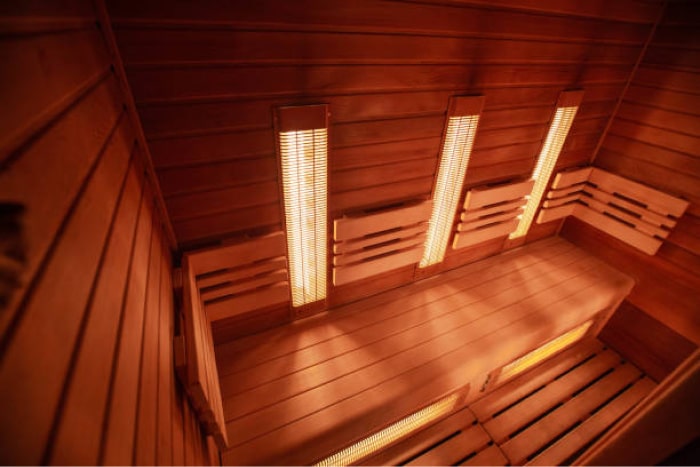Infrared Sauna vs Traditional Saunas: Which One Is Best For You?

Infrared Sauna vs Traditional Saunas; What you need to know about each one to help you choose.
Choosing a sauna can be a difficult decision, especially when your knowledge is limited. In this article you will find everything you should know about traditional home saunas, compared to infrared saunas, to help you make the best decision for you.
When you think about a sauna, the first thing that probably comes to mind are the traditional home saunas with a wood cabin and a source of heat. You probably imagine yourself sitting inside the cabin, wrapped in a towel, reveling in the warmth of the experience, and maybe even pouring some water over heated rocks to produce some steam. But, did you know that this isn't the only type of sauna available today? With the advances in technology, the sauna experience you imagine is no longer the only option, which brings us to a decade long battle between infrared sauna vs traditional sauna. While both types of saunas come with numerous benefits, the one you ultimately select will depend exclusively on your specific needs. So, in order to dispel some myths behind both types of saunas, let's take a look at what makes them different.
Traditional Home Saunas: Wet Or Dry?
Traditional sauna kits are available in two different types: wet or dry saunas, but they are both essentially the same because they consist of a wood cabin and a source of heat. The major difference resides in the fact that while a dry sauna only emits heat, traditional wet saunas also include a source of steam to induce a more profound sense of relaxation and well-being. In this manner, traditional sauna kits can include different types of rocks, over which you can pour water when they are hot to produce the steam you require to enhance your experience. Traditional home saunas heat your body from the outside, with temperatures that range between 180 and 190 degrees, which means that your core will not be as hot as with an infrared sauna, and you won't sweat as much.
Infrared Sauna vs Traditional Sauna: important Differences
As mentioned above, traditional home saunas will increase your body's temperature from the outside, while infrared saunas will use light waves to heat your body from the inside. As the temperature of your core starts rising, you will start to sweat profusely, which allows for the efficient detoxification of your body. On the other hand, because they rely on the use of light, infrared saunas are much cooler than traditional sauna kits, which rely on an external source of heat. This allows for longer sessions in an infrared sauna, in comparison to traditional home saunas. While traditional home saunas must function at 180-190 degrees to achieve the desired result, infrared saunas maintain a lower temperature that ranges between 120 and 140 degrees.
This, of course, does not mean that one is better than the other one, and the final decision will be based on your own preferences. Traditional sauna kits are designed to be more natural and closer to the ancient steam bath experience, while infrared saunas rely on the use of technology to work effectively. It all boils down to how you plan on using your sauna, and how intensively you want to sweat. If you are looking for a more natural and relaxed experience, traditional home saunas are possibly the best choice for you, but if what you want is an intensive sweating session, infrared saunas may be more appropriate. In the end, the choice is yours and should only depend on what you want.
One other major difference between infrared sauna vs traditional sauna is the time required to reap the benefits they both produce. Because of the way it works, an infrared sauna will take less time to heat up than a traditional sauna. As you now know, the light emitted by an infrared sauna heats your body from the core, and traditional home saunas have to heat the air outside your body in order for them to start producing the desired effects. This translates into about a half an hour wait for traditional sauna kits, whereas infrared saunas can be used almost right away.
Infrared Sauna vs Traditional Sauna: What Are The Benefits?
Both types of saunas can produce similar benefits, including deep relaxation, detoxification, improved circulation, and the relief of pain. They also work great at stress reduction and the improvement of your skin's overall look and feel. However, infrared saunas produce a more intense detoxifying effect, while traditional sauna kits are a better option for those with chronic respiratory conditions. Traditional home saunas help permeate the lungs to soften the mucus trapped within them much more effectively than infrared saunas, especially when the steam is combined with essential oils such as eucalyptus or lavender. On the other hand, when dealing with chronic pain, an infrared sauna is better at producing deep muscle relaxation. Regardless, the therapeutic and relaxing effects of any type of sauna are well-known, and can produce benefits that will reflect positively on your body and your state of mind.
In the end, the winner of the infrared sauna vs traditional sauna will depend exclusively on your own desires, the size of your home, and the space you have set aside for your new sauna. Don't forget to keep in mind important factors, such as your budget and needs before making your final choice In the end, the benefits you reap from your sauna will help you live a healthier and more relaxed life, with less pain, stress, and anxiety, especially when you add essential oils and scents into the mix. Don't forget to consult with your physician about your sauna regimen if you have any type of health condition, including cardiac or respiratory diseases, in order to ensure a healthy, and relaxing experience designed to benefit your body, mind, and soul.
